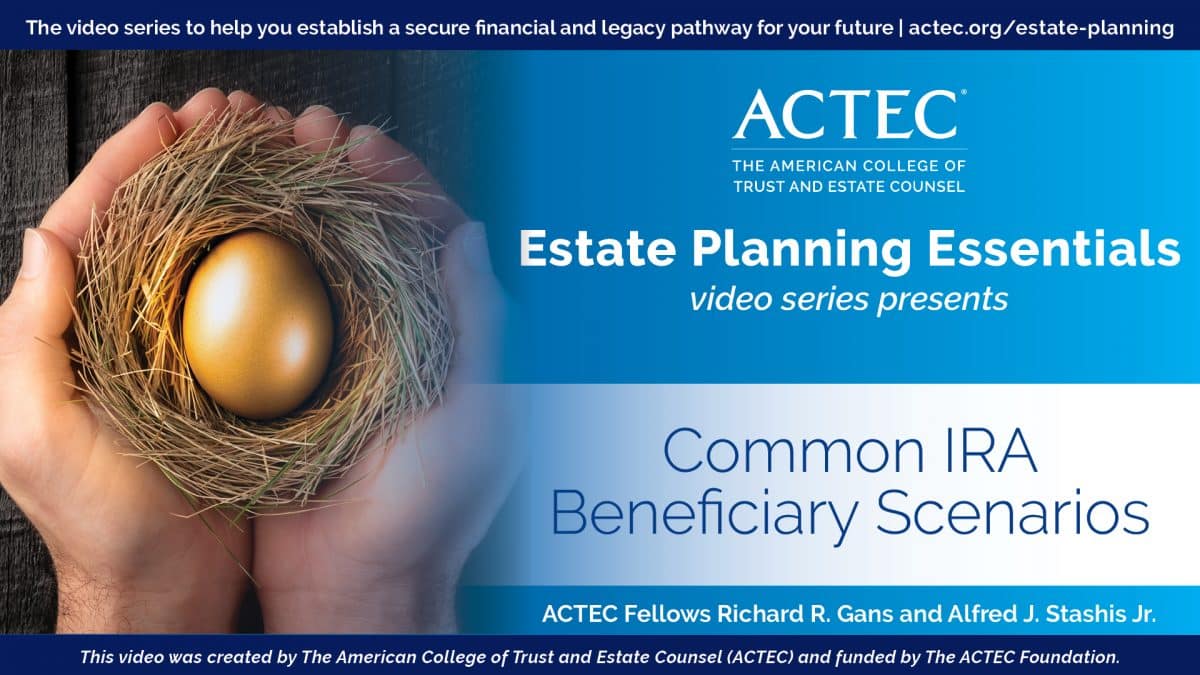A Pay on Death (POD), aka Transfer on Death (TOD) and Totten Trust, allows the account owner to designate a specific beneficiary who will receive the funds in the account upon their death, bypassing the probate process. This can help ensure a smooth and efficient transfer of assets to your intended recipient, providing financial security and reducing the burden of legal proceedings for your loved ones, but there are some drawbacks.
ACTEC Fellows Natalie M. Perry and Rebecca Wallenfelsz explain how Pay on Death accounts work and what account owners should be aware of before identifying a beneficiary on the form.
Relevant videos from ACTEC Estate Planning Essentials Library
Transcript
Hi, I’m Natalie Perry, ACTEC Fellow from Chicago, Illinois, and I’m here with Rebecca Wallenfelsz, ACTEC Fellow from Chicago, Illinois. We’re going to talk today about Pay on Death accounts, also known as PODs, Transfer on Death accounts (TOD), and sometimes called Totten Trust accounts. And what these are is a type of financial account (Rebecca’s going to expand on this for us during our video) that you can designate a beneficiary on, and that may or may not work well for your planning, depending on what you’re trying to accomplish.
Pay on Death Account / Transfer on Death Account
So Rebecca, could you give us a little more background on what these types of accounts are and how they work?
Rebecca Wallenfelsz: Well, Natalie, certain types of assets come embedded with a beneficiary designation form. Specifically, you think of life insurance and all retirement accounts. The nature of that type of asset is there’s a beneficiary form that’s provided when you create a new account or purchase a life insurance policy, and people are used to filling that out.
But what some people don’t know is that a lot of financial institutions and banks give you that same option when you create a bank account, a savings account, a checking account, a CD, a money market account. For a lot of brokerage accounts, you can do that as well. It’s just that you have to ask the financial institution or the bank for the form. It’s not automatically a part of the account form. And then you can fill out a beneficiary designation, much like you do for an insurance policy or retirement account, to name a beneficiary who gets that asset at your death.
Transfer on Death Deed
Increasingly, there are a lot of states, Illinois being one of them (where I live) that allow you actually to do this for real estate, so I can do what’s called a transfer on death deed and record it to name a beneficiary to receive my real estate in Illinois when I pass away.
Natalie Perry: Okay, great. I think that some banks will even put that form in front of a client who may not be expecting it. So, could you tell us, are these always a good idea? And what are some pitfalls when you’re using them?
Considerations for Pay on Death Accounts
Rebecca Wallenfelsz: Well, these may or may not be a good idea. It just kind of depends on what your estate planning goals are. So usually, the benefit that is touted, oftentimes by the banker or broker that you’re dealing with who is suggesting using this form, is that it avoids probate. You don’t have to go through a probate process for the named beneficiary to be able to collect the assets.
Usually, it’s as simple as when you pass away, the beneficiary gets a copy of the death certificate. They go to the finance institution. They give them a death certificate, verify whatever information they need to confirm who they are, and then they’re able to collect and receive the assets. So, it has a simplicity associated with the collection. And that’s usually why these things are touted as, hey, here’s something that’s important for you to do or relevant for you to have.
The drawback of this is:
- One, those beneficiary designation forms are often fairly simple. Usually, they just have a form there where you can name the person, and maybe at most the percentage that they’re getting. What they often lack is a specificity about what happens if that person dies before you. So that’s one drawback.
- And then the second is those beneficiary designation forms supersede anything you say in a will. So if they’re not consistent with what you said in a will, if you have one, this asset is going to be distributed specifically in the way it says in the beneficiary form or any default rules under that form. So that’s always something to be careful of when you’re filling that out.
Complexities of Pay on Death Accounts
Natalie Perry: Okay, and it sounds like the values could interplay with the beneficiary designation whereas, if you put child one on one account and child two on a different account, could that end up in an unequal distribution?
Rebecca Wallenfelsz: It could, right, because it’s just whatever is in that account and valued at the time you pass away. That’s what that beneficiary is inheriting.
You know, the other thing that is a complexity that I find people don’t understand, and certainly sometimes bankers and brokers don’t appreciate, is when you set up your assets. Because theoretically, depending on what state you live in and what financial institutions you have your accounts with, you could set up all of your property to be beneficiary designation—on your retirement accounts, life insurance, checking account, savings account, investment management account, and real estate. But when you do that, what is not provided for in any of those documents is the practical question of who is then responsible when you die to pay the funeral bill? Where does that responsibility reside? What if you have medical bills that are unpaid? What if you have credit card debt? What if you have income taxes that have to be paid?
So one of the biggest drawbacks is, depending on what state you live in, that the state may not have any particular rules about whose obligation it is to pay that. So, if you add that with the idea also that you name different people for those different assets, you can have a really complex situation.
Natalie Perry: It does sound like they’re a simple way to achieve what you want, but they come with a lot of pitfalls. So, is there any kind of bottom line that we should leave viewers with?
Rebecca Wallenfelsz: Yes, as always, talk to your favorite estate planning lawyer and expert. They can usually walk you through looking at what your desires are in terms of how you want to leave your property, whether you need a will, a living trust, or whether certain assets may benefit from Payable on Death or Transfer or Death, consistent with your desires and goals, as well as letting you know when do you need to keep an eye on those beneficiary designation forms so that you know you need to update them if something happens to a beneficiary or if your intentions change.
Natalie Perry: Thank you, Rebecca. This is very helpful. And in our video library, we do have a few other videos that address this topic, for example, Should I have my Daughter on my Bank Account? Thank you.
Rebecca Wallenfelsz: You’re welcome.
Featured Video
Common IRA Beneficiary Scenarios
There are no do-overs with IRA beneficiaries! Understand the typical IRA beneficiary scenarios and why reviewing every time you set up an IRA is critical.
ACTEC Estate Planning Essentials

ACTEC Fellows provide answers to frequently asked trust and estate planning questions in this video series.



